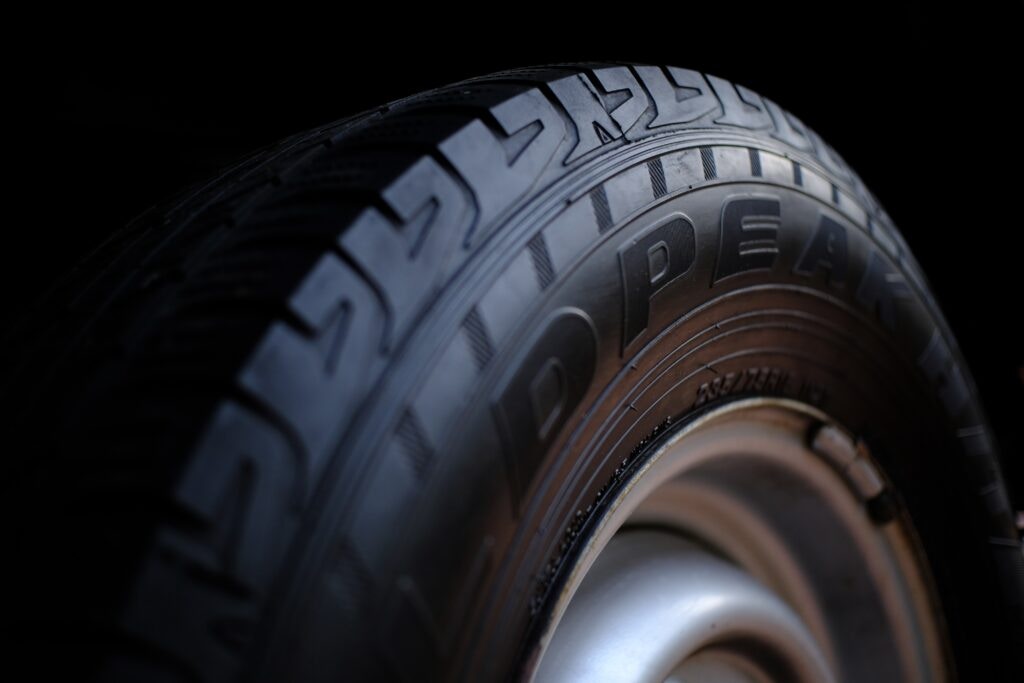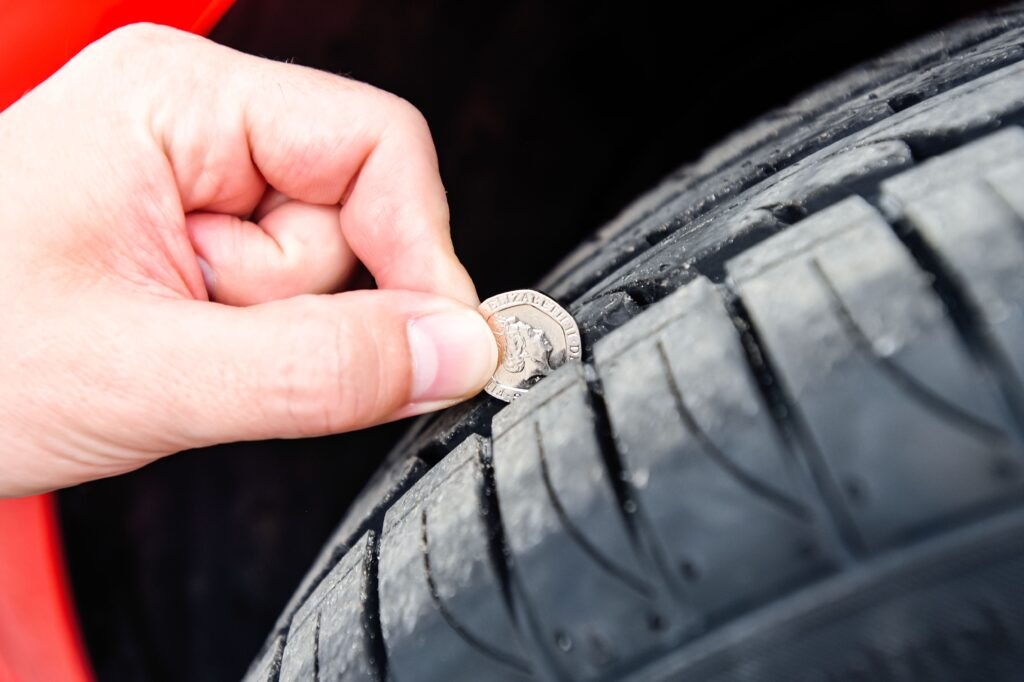How to check tyre tread depth – Three easy methods

A professional level tread depth gauge helps you to carry out reliable, regular checks
Ensuring your car’s tyres maintain a safe and legal tread depth is crucial. Read on to learn about tread depth requirements in the UK and easy methods to check yours.
Keeping your tyre tread well above the 1.6mm legal limit is a vital maintenance requirement that also enables you to keep the value of your car high when you do decide to sell.
Key info:
- Ways to check your tyres tread depth – Learn easy, at-home ways to measure your tread depth.
- Legal tread depth – The UK’s legal minimum depth is 1.6mm.
- Maintaining tread depth – Keeping your tyres in good condition is essential for safety and avoiding fines.
- Consequences of bald tyres – Explore the risks and legal implications of driving with worn tyres.
This guide helps you learn how to measure your tyre tread depth using three tried and tested methods, as well as how to maintain a good tread depth and whether your tyres will fail an MOT due to a low tread.
- Three easy ways to measure your tyre tread depth?
- Typical new tread depths for different classes of vehicle
- What is the legal tyre tread depth
- Should the minimum tyre tread be higher?
- What are the consequences of illegal or bald tyres?
- What happens if my tyres fail an MOT?
- How to maintain good tyre tread depth?
- FAQs

Three easy ways to measure your tyre tread depth
You’ll be surprised at how simple these methods are to do at home, with no need to visit a garage in the first instance.
1. Tread depth gauge
A tread depth gauge is a precise tool for measuring tread depth accurately. To use it, insert the gauge into the tread groove, push it down until it touches the tyre’s surface, and then read the measurement displayed on the gauge in millimetres.
This method offers the most accurate and specific measurements, making it ideal for assessing subtle changes in tread depth. However, it does require purchasing a gauge, which is an additional cost.
2. The 20p test
The 20p test is a simple, free method for a quick tread depth check. To perform it, take a 20p coin and insert it into the main tread grooves of your tyre. Ensure the border of the coin is fully covered by the tread. If the outer border of the coin is visible, your tread is dangerously low, and it’s time to replace your tyres.
This method is quick and easy, doesn’t require special tools, and provides a simple pass/fail result. However, it may not be as precise as a dedicated tread depth gauge and doesn’t measure the exact depth in millimetres.

3. Wear Bars
Most tyres have wear bars moulded into the tread grooves during manufacturing. You can inspect your tyre’s tread for these small, raised bars running across the grooves at any time. When the tread wears down to be flush with the main level of these bars, it’s time to replace the tyre.
Wear bars work as a built-in visual indicator to help you stay safe, eliminating the need for additional tools.

Typical new tread depths for different classes of vehicle
New tyres generally have tread depths of 8-9mm. Here’s a more in-depth look at new tyre tread depths for different vehicle types:
| Vehicle type | Recommended tread pattern | New tyre tread depth | Tread benefits |
| City cars | Standard, all-season tread pattern | 8-10mm | Good traction on wet and dry city roads |
| SUVs | All-terrain or off-road tread patterns | 10-12mm | Traction on various surfaces, from city roads to rugged terrains |
| Trucks | Heavy-duty or commercial-grade tires | 14-16mm | Sturdy tread patterns for load-bearing capabilities |
| Sports cars | High-performance or summer-specific treads | 6-8mm | Exceptional grip and handling for fast and agile driving |
What is the legal tyre tread depth?
In the UK, the legal minimum tyre tread depth is 1.6mm across the central 3/4 of the tyre. This means that the tread on your tyres must meet or exceed this depth to comply with the law. It’s important to note that this requirement applies to each tyre on your vehicle.
If any of your tyres fall below the legal tread depth, you could face penalties, fines, or even points on your driving license.
Should the minimum tyre tread be higher?
While 1.6mm is the absolute minimum tread depth required by law, it’s highly advisable to replace your tyres before they reach this point. Many experts recommend changing your tyres when the tread depth approaches 3mm for safety reasons.
What are the consequences of illegal or bald tyres?
Driving with bald or shallow-depth tyres in the UK can have serious consequences, both in terms of safety and potential legal ramifications:
- Reduced road grip – Bald and worn-out tyres have significantly reduced traction, especially in wet or slippery conditions. This can lead to longer braking distances and an increased risk of skidding or losing control of your vehicle.
- Penalties and fines – If you’re caught with bald tyres, you can face steep fines, and penalty points on your driving license. These penalties are serious and can have long-lasting consequences.
- Insurance implications – If you’re involved in an accident with tyres below the legal tread depth, your insurance company may refuse to cover the damages, leaving you liable for repair costs.
- MOT test failure – During your vehicle’s annual MOT, bald and excessively worn tyres can lead to an automatic failure. This means you’ll have to replace your tyres to pass the test, incurring additional expenses.
- Endangering lives – Most importantly, driving with bald or worn-out tyres endangers lives, including yours. Reduced grip and control make accidents much more likely.
What happens if my tyres fail an MOT?
In the UK, tread depth is a key part of MOT tests. If you fail your MOT, you can’t legally drive your vehicle on public roads until the faults are fixed. Another costly consequence can be a penalty charge notice. Continuing to drive with failed tyres can incur fines of up to £2,500 and penalty points on your licence.
When your car fails the MOT due to tread depth, the solution is straightforward but urgent:
- Replace tyres: You’ll need to replace the worn or bald tyres with new ones. It’s essential to choose tyres that meet or exceed the legal tread depth requirement.
- Re-test: After replacing the tyres, your vehicle must undergo an MOT re-test to ensure your vehicle now meets the safety standards.
How to maintain good tyre tread depth
While 1.6mm is the absolute minimum tread depth required by law, it’s highly advisable to replace your tyres before
Your maintenance and driving habits contribute to your tyre health, reducing your costs and keeping you safe on the road.
Regular inspections
It’s worth regularly examining your tyres for signs of wear, cracks, and embedded objects like gravel. Check the tread depth using one of the three methods given above. If you notice uneven wear patterns between the tyres, it could indicate alignment or suspension issues.
Proper inflation
Maintaining optimum tyre pressure is crucial. Consult your vehicle’s manual for the recommended pressure in its tyres. Proper inflation helps your treads to wear evenly and can improve fuel efficiency.
Wheel maintenance
Balance, align, and rotate your tyres as needed. It’s important to make sure your tyres are all taking equal weight, so they don’t wear down prematurely.
Safe driving
Your habits significantly impact tyre tread wear. Smooth and controlled driving, characterised by gentle braking, gradual acceleration, and avoiding aggressive cornering, will preserve your tyres.
Keep your car’s value high
Maintaining good tyre tread depth is one of the maintenance elements that keeps your vehicle value strong once you’re ready to sell.
If you’re unsure about whether the cost of replacing your tyres is worth it, get a free, instant valuation based on up-to-the-minute market data by entering your reg on the Motorway homepage or app. This valuation will assume perfect condition – so if your treads are nearly bald, you’ll have to factor in the cost to replace the tyres, too.

When you’re profiling your car on Motorway, you’ll just have to answer a few easy questions, and we’ll guide you through the photos you need to take. It can be done right from your phone – in a matter of minutes.
If you choose to enter your car into an online daily sale, it will be shown to our nationwide network of more than 7,500 verified dealers looking to add to their stock of used cars. Interested dealers will then compete to buy your car, offering you their best price.
In as little as 24 hours you will receive your best offer – and, if you choose to go ahead with the sale, your car will be collected for free by the dealer and the money will be quickly and securely transferred to your bank account.
FAQs
Should your tyre tread depth change in different seasons?
Healthy tyre tread depth is essential in all seasons. In wet and cold months, deep tread enhances grip on wet and slippery roads, providing traction on debris, snow, and ice. Summer demands tread for easy handling and wear resistance on hot, dry roads.
Is 2mm tyre tread legal?
Yes, a 2mm tyre tread is legal in the UK. The legal minimum tread depth is 1.6mm. It’s advisable to replace tyres well before they reach 2mm for safety.
How long will 3mm tyres last?
The lifespan of 3mm tyres depends on your driving habits and the road conditions you drive on. They typically last from 10,000 to 20,000 miles, but regular checks are essential.
What is the legal limit for tyres to pass an MOT?
For tyres to pass an MOT in the UK, they must have a minimum tread depth of 1.6mm across the central 3/4 of the tyre. Falling below this limit results in an MOT failure.
Need to sell your car?
Want to learn more about owning, maintaining, and selling your car? Check out more of our guides here, covering everything from Clean Air Zones to car tax, and plate changes to part exchange.
- How to tax your car – The ultimate guide to car tax
- How to sell a car on Motorway
- V5C – The ultimate guide to the V5 Logbook
- How to get cash for your car
- How to sell a car with a V5C
- Car selling tips
- The DVLA and selling your car – the ultimate guide
- How to transfer car ownership
- Car buying sites to sell online
- How to get the best price for my car
The information provided on this page is for general informational purposes only and should not be considered as professional advice.